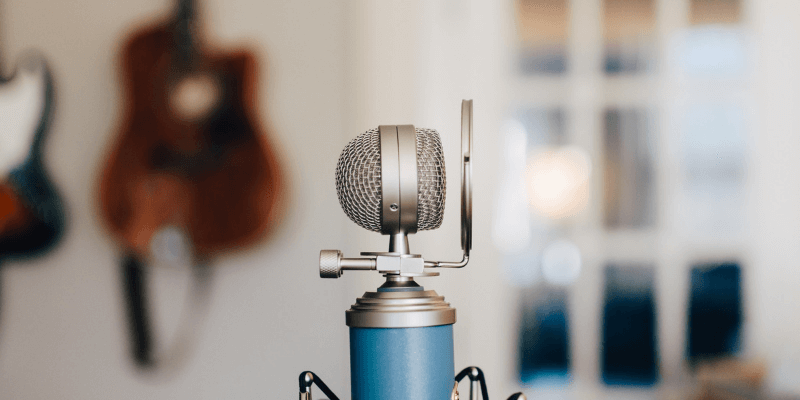Do you want to use a professional microphone with your laptop, but aren't exactly sure how to do it?
These days, there are plenty of great USB mics offering high-quality audio and plug-and-play convenience for computer recording. But they're not always the solution for everyone. Perhaps you already have a traditional microphone you'd like to use with your laptop or maybe you're after a distinct sound that a USB model simply can't provide.
Of course, plugging in your trusty SM58 isn't so straightforward: Laptops, as well as desktop PCs and Macs, normally have 3.5 mm jacks, whereas most professional mics use XLR plugs. Unless you're handy with a soldering iron, you're going to need a special cable like the RP325.
Still, even with your mic plugged in, you might not be all that satisfied with the sound quality of your recordings. That's because the onboard audio inputs on most computers aren't sensitive enough to pick up the signal from your microphone, so it will likely sound either too quiet or too noisy when amplified by your audio software.
Potential solutions
Logitech - H800 Wireless Headset - Black. PowerMic Mobile is an iPhone and Android app that lets clinicians use their own smartphone as a dictation microphone at any workstation with Dragon Medical. It’s easy to use and pairs instantly and securely. There’s no hunting for a dedicated USB‑microphone, so clinicians can spend more time with patients, capture notes while information.
Option 1: A passive transformer
Using a passive transformer like the A96F can boost a signal by 12 dB. However, this has the disadvantage of giving the microphone a low-impedance connection, which can impair the sound quality. That makes this option best for a quick-and-dirty solution when you don't have access to an external power source. This will only work with dynamic microphones.
Option 2: A small mixer
You can also increase the microphone signal to line level with a small mixing console, but you'll still need an adapter cable to connect to the computer's standard audio jack. This method eliminates having to amplify the signal with your recording software, hopefully eliminating any unwanted background noise in the process. And if the mixer supports phantom power, you can also use condenser microphones.
Option 3: A portable interface
If you're recording on the go with your laptop, a portable audio interface might be what you're after. There are single-channel analog-to-digital converters like the X2u connecting an XLR mic to the computer's USB port. Or you can opt for something like the MVi, an interface offering a selection of onboard signal-processing presets. Both work without external power, so you can record wherever you can set up your laptop. They also provide phantom power for condenser microphones and have headphone jacks for latency-free monitoring.
Option 4: A new soundcard
If you want to set up your own home studio, you might consider getting a multichannel soundcard for your computer. There are both external and internal PCI models available, but there are a few things to keep in mind while shopping for one. Besides having a reputation for premium sound quality, be sure the soundcard uses drivers ensuring low latency – and phantom power if you want to record with condenser mics.
Option 5: A USB microphone
Sometimes, you need to look at your gear situation and reassess what works best for your goals. Though we certainly have sympathy for your deep emotional attachment to your first SM58, it might be time to consider buying a USB microphone after all. Beside the ease of use, the main advantage is sound quality far superior to your computer's onboard audio, since the signal is digitized before it leaves the mic. Because of this, however, it's important to pick a model best suited to your needs. There's the MV5 for podcasting and other spoken-word audio, and the MV51, a large-membrane condenser mic with built-in signal processing presets, great for capturing both vocals and instruments.
Power Mic For Mac
Pro tip:
Some condenser microphones, especially those developed for home recording, can run on batteries. So these models can still be used even if you don't have phantom power available.
*Latency occurs when an analogue signal from a microphone is digitized inside the computer and is played back for monitoring purposes with a slight delay. Normal soundcards can have latency of up to quarter of a second – far too long for professional recording purposes. Pro audio equipment keeps latency below four milliseconds, and the X2u interface even has a headphone jack providing a latency-free analog signal before it is digitized and sent to the computer.
Hello All,
After recently buying a Neewer NW-700 and setting it up, I plugged it into my what I believe to be a 2012 or 2013 model of the Mac Book Pro, only to see that it was received as headphones and under the output tab of my sound preferences. I don't believe there is anything wrong with the mic as I had also bought and hooked up a phantom power source. After running the cables through the power source I plugged my TRS plug into an additional FosPower TRS to TRRS adapter, knowing that macs don't accept TRS audio jacks. And then after all that, I plugged that adapter into my computer which accepted it as a headphone rather than a microphone.
I do have a theory, that the FosPower Adapter only converts input signals and that the computer then thought of it as a headphone. What do you think?
Here are some pictures to help.
The Mic

The Phantom Power
Adapter
Power Mic For Mac Windows 10
Prior to Plug in
After Adapter was plugged in
Thanks for your help,
G
Microphone For Mac Air
MacBook Pro (13-inch Mid 2012)
Power Mic For Mac Keyboard
Posted on